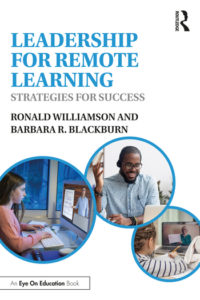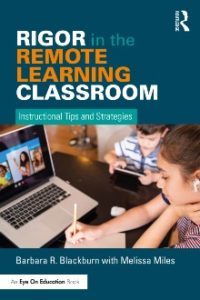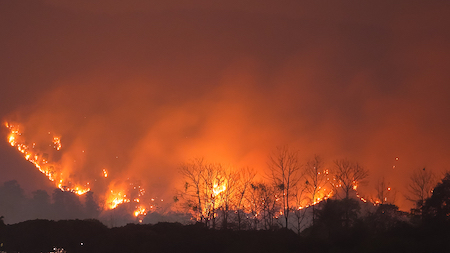What Leaders Can Do to Prepare for 2021-2022
By Ronald Williamson and Barbara R. Blackburn

Ronald
Across America and around the world you could hear a big sigh of relief as the school year began to end. It was one of the most remarkable school years in history and left many teachers and principals, as well as students and their families, exhausted.
However, for school leaders, the end of one year always signals the beginning of another. There’s usually a little extra time for R&R, but summer is still very busy in the admin office.

Barbara
There are people to hire, schedules to create, students to register, and budgets to develop. This summer all of those routine things are matched by the need to recover from the effects of the pandemic and address issues that emerged as a result of school closures and other disruptions.
We talk with lots of school leaders, and despite the disruption they’ve experienced, they describe some important lessons that can be applied to good effect in the coming school year (and the next).
1. People are hurting.
Life’s routines and regularities have been disrupted. New norms have emerged. It’s important to acknowledge the disruption and trauma that people experienced, and to support them in their discouragement and grief. But it’s also important to help them develop the coping skills to move forward.
We have found that personal writing can help your faculty and staff. First, provide the opportunity for them to literally vent their feelings about the past. Ask them to write down everything that frustrated them, everything that caused them sorrow, and all the events that were simply bad from their perspective.
Next, if they would like, allow them the opportunity to share excerpts from their list, whether it is with one other person, a small group, or the entire faculty and staff.
Once they have finished looking back, provide an opportunity to look forward. We have described this activity before, but it is particularly useful in this setting.

Staff can do a similar letter, but tailored to their roles. Leaders can adapt this visioning process and – again writing from the perspective of early next summer – tell what happened with teachers and staff, and how leadership helped make it a productive, positive year.
Leaders can share their letters with others, but we highly recommend you invite faculty and staff to share theirs with you. Then ask them, “How can I help you accomplish your vision?” This will make you better able to support them.
2. Adoption of online or hybrid learning affirmed that students learn in very different ways and in different modalities.
We learned that many students thrive in an online environment, while others struggle. The same is true for teachers. It’s something educators have always known but too often fail to accommodate.
Moving forward, many schools and districts plan to retain on online option for students. In some cases it’s their own virtual school. In others it’s as part of a consortium of schools in the local RESA (Regional Educational Service Agency) or similar alliances.
What’s essential is to recognize that the return to “normal” may be a “new normal,” one that incorporates more online learning opportunities. We’ve learned that there is no need to choose a single way of learning. Using the vision letter described above with teachers (and perhaps with students, adapted to the specific setting and age group), will help you address the “new normal” by identifying preferences and likely trends.
3. Hang on to what worked well.
There’s a lot of discussion about returning to “normal” or the way things were prior to the pandemic. That’s a seductive option for many folks. But many of the changes and accommodations that were implemented over the past year were successful. It’s important that school leaders not discard everything that was implemented. Hang onto the things that worked well. Discard the things that didn’t even if they are long-standing practices.
One strategy we saw in a school was that teachers worked together to identify strategies that did not work. When all teachers and leaders agreed on an ineffective strategy, teachers wrote it on a gravestone. At the end of the session, they “buried” the gravestones in a trashcan, confirming their commitment to not use them again.
A productive strategy to identify effective strategies is to ask teachers to provide specific examples of successes from their experiences last year. Post these online in a shared document folder, and ask teachers to work in small groups to determine how these will support your efforts moving forward.
4. Schools are inequitable places.
It’s clear that access to technology is not universal. The pandemic and schools’ move to online learning heavily underscored something we already knew. Many families, even in urban areas, lack access to robust Internet service.
This lack of access exacerbated equity concerns in thousands of schools. Once again, many families found themselves marginalized from full participation in the public learning space. This inequity exacerbated the differences already present among poor and other marginalized communities.
Here, too, it’s vitally important that we reflect upon the past year so we can learn from our experiences. As schools return to “normal,” it is important to recognize that many families continue to be unable to read online newsletters, respond to online invitations, or access teacher websites and student assignments and resource networks.
Working together to detail specific equity issues, as well as describing what worked and what didn’t, will help to inform your next steps.
5. Prepare for the next disruption.
We can hope this is the last pandemic we’ll all experience. Perhaps it will be. But one thing is assured. There will be other disruptions to school life. It may be a hurricane, a serious tornado outbreak, an earthquake, wildfires, or a vicious winter storm. Regardless, it’s critical that schools update their emergency plans.
Now that the pandemic has subsided, it is a good time to thoughtfully review the practices that have been adopted, identify strengths and weaknesses, and think about how to incorporate those plans into future emergency responses. There’s no need to learn the lessons all over again. A strong emergency plan should include:
• Description of emergency type
• Immediate steps to be taken
• Communication of plan for all stakeholders
• Support plan for teachers
• Resource needs from outside the school
• Ongoing communication plan
• Options with and without technology
Moving beyond a major crisis into positive forward motion for the future is not easy. Despite the challenges, providing your faculty and staff with opportunities for self-reflection and shared decision-making will ensure that you can proceed with success.

































